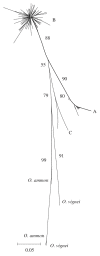Genetic diversity of sheep breeds from Albania, Greece, and Italy assessed by mitochondrial DNA and nuclear polymorphisms (SNPs)
- PMID: 22125424
- PMCID: PMC3201683
- DOI: 10.1100/2011/186342
Genetic diversity of sheep breeds from Albania, Greece, and Italy assessed by mitochondrial DNA and nuclear polymorphisms (SNPs)
Abstract
We employed mtDNA and nuclear SNPs to investigate the genetic diversity of sheep breeds of three countries of the Mediterranean basin: Albania, Greece, and Italy. In total, 154 unique mtDNA haplotypes were detected by means of D-loop sequence analysis. The major nucleotide diversity was observed in Albania. We identified haplogroups, A, B, and C in Albanian and Greek samples, while Italian individuals clustered in groups A and B. In general, the data show a pattern reflecting old migrations that occurred in postneolithic and historical times. PCA analysis on SNP data differentiated breeds with good correspondence to geographical locations. This could reflect geographical isolation, selection operated by local sheep farmers, and different flock management and breed admixture that occurred in the last centuries.
Keywords: Mediterranean; SNPs; domestication; mtDNA; sheep.
Figures




Similar articles
-
Sheep Post-Domestication Expansion in the Context of Mitochondrial and Y Chromosome Haplogroups and Haplotypes.Genes (Basel). 2022 Mar 29;13(4):613. doi: 10.3390/genes13040613. Genes (Basel). 2022. PMID: 35456419 Free PMC article. Review.
-
Geographical patterning of sixteen goat breeds from Italy, Albania and Greece assessed by Single Nucleotide Polymorphisms.BMC Ecol. 2009 Sep 2;9:20. doi: 10.1186/1472-6785-9-20. BMC Ecol. 2009. PMID: 19725964 Free PMC article.
-
Mitochondrial DNA of seven Italian sheep breeds shows faint signatures of domestication and suggests recent breed formation.Mitochondrial DNA. 2013 Oct;24(5):577-83. doi: 10.3109/19401736.2013.770493. Epub 2013 Apr 2. Mitochondrial DNA. 2013. PMID: 23544453
-
Genomic diversity and population structure of three autochthonous Greek sheep breeds assessed with genome-wide DNA arrays.Mol Genet Genomics. 2018 Jun;293(3):753-768. doi: 10.1007/s00438-018-1421-x. Epub 2018 Jan 25. Mol Genet Genomics. 2018. PMID: 29372305
-
Research advances on the origin, evolution and genetic diversity of Chinese native sheep breeds.Yi Chuan. 2017 Nov 20;39(11):958-973. doi: 10.16288/j.yczz.17-102. Yi Chuan. 2017. PMID: 29254917 Review.
Cited by
-
Sheep Post-Domestication Expansion in the Context of Mitochondrial and Y Chromosome Haplogroups and Haplotypes.Genes (Basel). 2022 Mar 29;13(4):613. doi: 10.3390/genes13040613. Genes (Basel). 2022. PMID: 35456419 Free PMC article. Review.
-
Retrospective and prospective perspectives on zoonotic brucellosis.Front Microbiol. 2014 May 13;5:213. doi: 10.3389/fmicb.2014.00213. eCollection 2014. Front Microbiol. 2014. PMID: 24860561 Free PMC article. Review.
-
Evaluation of Maternal Genetic Background of Two Hungarian Autochthonous Sheep Breeds Coming from Different Geographical Directions.Animals (Basel). 2022 Jan 18;12(3):218. doi: 10.3390/ani12030218. Animals (Basel). 2022. PMID: 35158542 Free PMC article.
-
Phylogenetic relationships of three Italian merino-derived sheep breeds evaluated through a complete mitogenome analysis.PLoS One. 2013 Sep 9;8(9):e73712. doi: 10.1371/journal.pone.0073712. eCollection 2013. PLoS One. 2013. PMID: 24040036 Free PMC article.
-
Genomic signatures of selection, local adaptation and production type characterisation of East Adriatic sheep breeds.J Anim Sci Biotechnol. 2023 Nov 6;14(1):142. doi: 10.1186/s40104-023-00936-y. J Anim Sci Biotechnol. 2023. PMID: 37932811 Free PMC article.
References
-
- Vigne JD, Carrère I, Guilaine J. Unstable status of early domestic ungulates in the Near East: the example of Shillourokambos (Cyprus, IX-VIIIth millennia Cal. B.C.) Bulletin de Correspondance Hellenique. 2003;43, supplement:239–251.
-
- Nadler CF, Korobitsina KV, Hoffmann RS, Vorontsov NN. Cytogenetic differentiation, geographic distribution, and domestication in Palaearctic sheep (Ovis) Zeitschrift für Säugetierkunde. 1973;38:109–125.
-
- Bunch TD, Foote WC, Spillett JJ. Translocations of acrocentric chromosomes and their implications in the evolution of sheep (Ovis) Cytogenetics and Cell Genetics. 1976;17(3):122–136. - PubMed
-
- Dobney K, Larson G. Genetics and animal domestication: new windows on an elusive process. Journal of Zoology. 2006;269(2):261–271.
Publication types
MeSH terms
Substances
LinkOut - more resources
Full Text Sources

